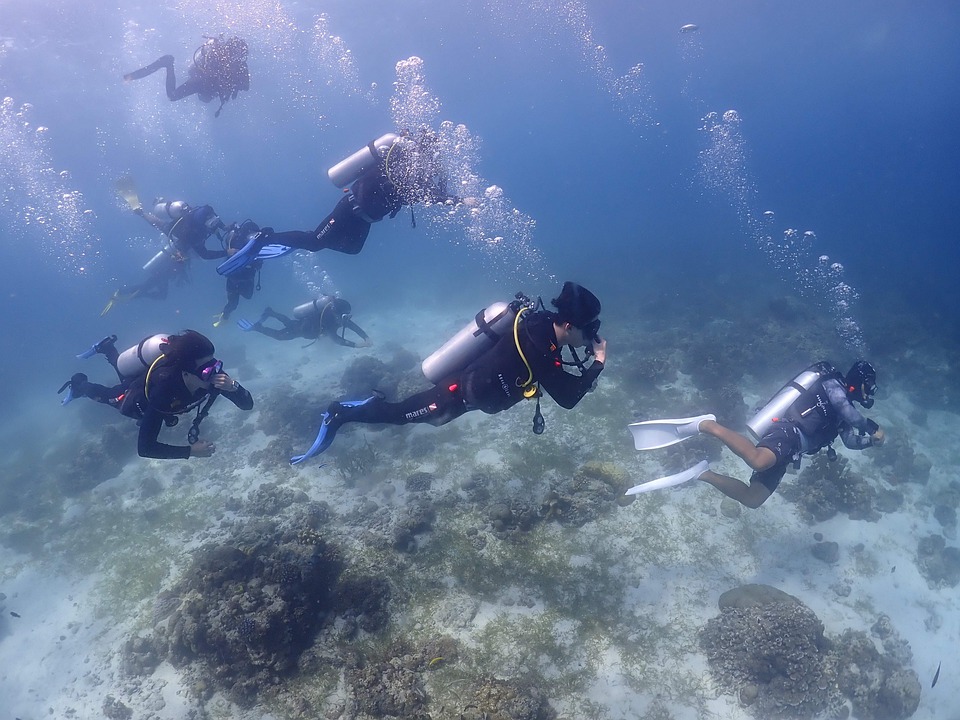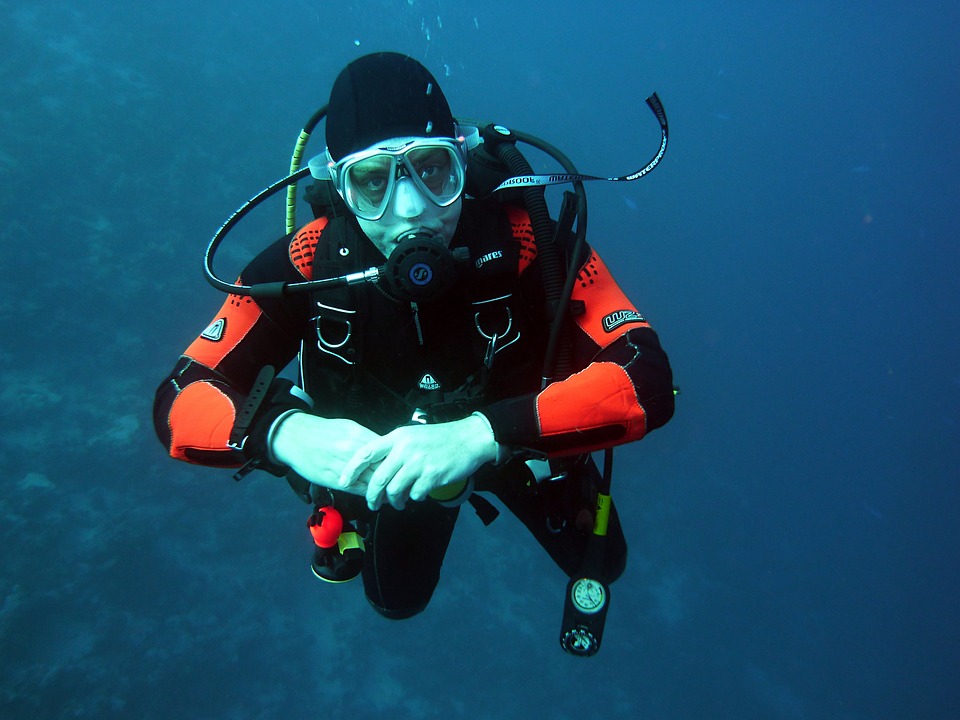The picturesque setting above and the aquatic realms below in Maldives is so stunning that it makes you feel like you are dreaming. To experience the underwater environment which is in abundance here, Scuba diving is an incredible way to explore. The islands of Maldives is blessed with beautiful atolls, coral reefs, coral islands and an array of aquatic species, making it a world-class scuba diving destination. From normal dives to wreck diving, drift dives to reef dive, there are multifarious activities to choose from. A sense of calm that washes over you while scuba diving is one of a kind experience. So come let’s dive in to know more about scuba diving in Maldives.
Table of Contents
Best Time To Go Scuba Diving In Maldives

Maldives is a year round destination, however if you are looking for scuba diving in the Maldives, then it’s best to avoid the monsoon season. The thumb rule for scuba diving is: experience is at its best when the underwater visibility is excellent. Maldives enjoys a tropical climate where temperatures range between 80 to 86 degrees throughout the year. It is best to avoid the monsoon season (May to July) as wind and rain can affect the visibility which is not good for diving. The months of January to April have dry and warmer weather due to which the visibility is at its best, making it the best time for scuba diving. If you are diving to see the ‘big’ sea creatures such as manta rays and whale sharks, the months between August and November is the best time.
Where To Go Scuba Diving In Maldives
Maldives being one of the top destinations for scuba diving, there are many places to choose from for your diving experience. However we have rounded up the most trending of them all to make your experience more memorable.
Maaya Thila

Maaya Thila, one of the most popular in the Maldives is also one among the world top-ten for scuba diving. The awesome geographic features, its undisturbed beauty and its incredible coral and aquatic life is what makes this diving site unique. Maaya Thila is suitable for both beginners and advanced divers. The famous gray reef sharks, Angelfish, clownfish, turtles, frogfish, barracuda, and parrotfish are species that you are sure to spot.
Recommended Level of Diving: Medium to Advanced
Popular Sightings: Gray Reef Sharks
Banana Reef

Banana Reef on North Male Atoll is the most loved atoll of all as it is accessible to all. It is one of the first diving sites in the country to become popular among international travelers. The whole reef is shaped in the form of a banana, hence the name. At a depth of 5 to 30 meters, this reef has a bit of everything for divers to explore. Its dramatic cliffs, caves, excellent corals, sloping walls, big fishes and overhangs makes it a thrilling Maldives scuba diving site.
Recommended Level of Diving: Beginners to Advanced
Popular Sightings: Colorful coral growths and powerful overhangs
Fish Head

Fish Head also known as Shark Point and Mushimasmingili Thila is one of the very best scuba diving in Maldives site. Initially this reef was a shark feeding spot, however it is now declared a protected marine area by the government. Fish head gives divers a chance to see underwater caves, black corals, undersea rock formations and the sea creatures up close and personal. No wonder, the Fish Head diving site is on top of every scuba divers bucket list.
Recommended Level of Diving: Suitable for all levels
Popular Sightings: Unique rock formations
Fesdhoo Wreck

Located just off the coast of Fesdhoo is a shipwreck site that is often explored at night. The 30 meters long wreck lies at a depth of 18 meters with its bow facing north. Fesdhoo is known for its visiting manta rays and is best suited for nitrox divers. The entire wrecked ship is surrounded by diverse marine life, hard and soft corals. If lucky, one can spot white-tip reef sharks and hammerheads too.
Recommended Level of Diving: Best suited for nitrox divers
Popular Sightings: Wrecked ship with soft and hard corals
Rainbow Reef

Located in the North Male Atoll, it takes about 10 – 15 minutes ride from Girifushi by speedboat to reach Rainbow reef. Rainbow Reef also known as the HP reef and Girifushi Thila is a diving site for experienced divers. The currents are so strong that a lot of precaution and extra care needs to be exercised while diving here. It gets its name from the colorful corals that adorn its walls. Highlights of the reef is the 25 meter cave known as the ‘chimney’ and the variety of corals that’s found here.
Recommended Level of Diving: Intermediate and advanced divers
Popular Sightings: Chimney cave, reef sharks, eagle rays, pelagic, soft corals
Suggested Reads: Top 5 Scuba Diving Spots In India That You Shouldn’t Miss
List Of Scuba Diving Equipment For A Safe Diving Experience
In order to enjoy a safe and fun dive it is very important to be prepared with the right equipment. Before jumping into the tranquil blue ocean, make sure you have a set of the below mentioned scuba diving gears.

Diving Mask – One of the most important equipment for scuba diving is the diving mask which will help you see clearly underwater.
Wetsuit or Drysuit – These scuba diving suits are made of neoprene to help keep dry. It also locks a layer of water around the body to keep it warm.
Scuba Gloves – Scuba gloves help to keep hands warm underwater and also to prevent skin injuries when you are exposed to difficult underwater environments.
Fins – Another important essential scuba diving gear that lets you glide through the water with agility. There are two types of fins: open heel fins and full-foot fins.
Scuba Tank – The air that you need to breathe while underwater is stored in these tanks. These diving cylinders are filled with compressed air or specialized gas mixtures.
Regulator – It is a piece of equipment that allows you to take in the compressed air from your scuba tank and makes it possible to breathe underwater.
Depth Gauge, SPG, & Compass – Depth gauge helps to specify the current and maximum depths reached during a dive, SPG indicates the air available in the scuba tank and compass helps navigate underwater.
Dive Lights – It is an important diving equipment used while diving at night or while swimming through caves. During the day dives it helps bring out more color and visibility in the sea.
Things To Keep In Mind Before And After Scuba Diving In Maldives

- Most of the diving site booking gets booked 6 months in advance, hence plan in advance to avoid disappointments and last minute confusions.
- Do your research in advance, avoid choosing cheap options and stick to reputable diving centers.
- Make sure to swim horizontally like a fish and not vertically.
- Avoid overexpansion of lungs by breathing normally at all times and make sure never to hold breath.
- Ascend slowly by making safety stops between 3 and 6 meters to help the excess nitrogen to escape from the body.
- After a dive avoid activities such as running, lifting weights, or intense training to give time for your body to recover as it was subjected to different pressures.
- A diver should not take a flight for at least 18 hours to eliminate excess nitrogen from tissues. Failing to do so may result in decompression illness.
Also Read: 10 Water Sports In Maldives That Will Make You Want To Hit The Waters Right Away!
The crystal clear and warm waters of the Maldives are waiting for you! So now that you know it all, how about descending deep into the Maldives Sea with our list of top places for scuba diving in Maldives. If there is something you want to add from your scuba diving experience, do comment below.
Yes, it is absolutely safe for beginners to undertake Scuba Diving in Maldives. Ensure that all the guidelines are followed strictly for the safety of the divers.
Yes, but there are limitations to what a non-swimmer can do. The best option for a non-swimmer is to try snorkeling.
The cost of scuba diving in Maldives depends on where you are diving. Public diving centers are budget-friendly in comparison to the private island resorts. An average cost for scuba diving in Maldives can be anything between USD 50 to USD 150. This is inclusive of the boat transfer, tanks, diving gears and weights.
Depending on the depth and diver’s ability, the duration of a dive can be anything between 5-45 minutes.
Maldives is the most visited country for diving as every corner of the island has healthy reefs, clear blue water and all-time favorable weather conditions for scuba diving.
The risk of diving with sharks is incredibly low. Sharks found in the Maldives are mostly non-aggressive species with no reported shark attacks on humans so far.
The maximum depth for diving in Maldives is 30 m. However there are places where the depth limit for scuba diving is 60 ft. One needs to obtain advanced open water certification to dive into such sites.


